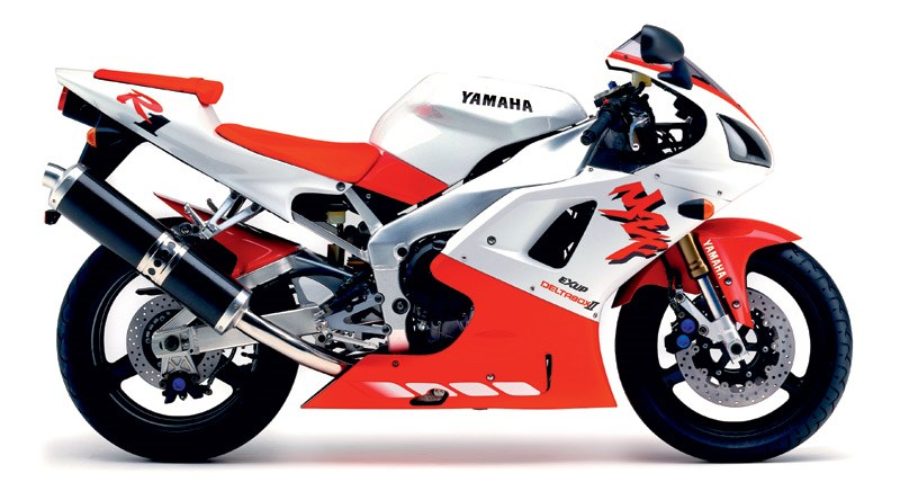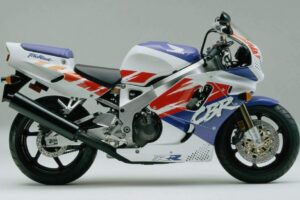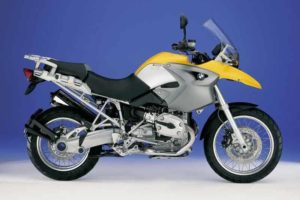1998 Yamaha YZF R1
Reset your mind for the R1. Your preconceived notions of the ultimate sportsbike are a distant speck in its mirrors. Your favourite mountain road is suddenly tighter and shorter than it was a week ago. Someone stole the straight bits from your local race track. God keeps reaching down and hoisting your front tyre. And there’s a bastard gremlin in the garage who gnaws at the rear tyre while you sleep.
The first time I flog the R1 at Eastern Creek, scary things happen. Actually, not in the first session. In that first one I wonder what the fuss is about. Then I change down a gear and all hell breaks loose. The back end drifts everywhere, the front end leaps skyward and corners rush to my wide eyes. I completely botch the remaining laps while I re-learn the track I used to know like my girlfriend’s inner thighs. Did she do a crash course at the gym or something?
The R1 is the smallest, lightest, most powerful sportsbike there is. Yamaha can brag about the basics: 110kW, 177kg and a 600-class wheelbase of 1395mm. It is the ultimate. It kicks arse and destroys egos. Blades, Ninjas, GSX-Rs, Dukes, the lot. When it comes to outright performance, here, now, the Rl is it. The engine isn’t just more powerful than anything else in the class. It has gobs more power. Everywhere. And it has such a tiny little chassis to push around. No-one has shoved the power-to-weight equation further than the R1. Yet.

All this ball-tearing performance can be bloody scary. Or it can be a purring pussycat. The choice is yours, because the R1 is so controllable, so easy to ride and responsive at any pace.
Think about it. The latest, greatest, lightest, most powerful superbike on the market is genuinely easy to ride. That’s a notion you just wouldn’t have contemplated 10 or 15 years ago.
The scary side of its performance is a wild, wheel-standing ride fuelled on adrenalin and encouraged by the devil. On a tight road you can leave it second gear and howl. On a more open road, try third gear for an incredible rush between 100 and 200km/h. Re-learn your favourite race track because you’ll come into every corner so much faster than before and pull wheelies all over the place.
That first time I ran the Yamaha around Eastern Creek I was in a higher gear than necessary and thought it felt like a FireBlade. When I changed down a gear I found the real top end. Scared the bejeezus out of me. I had to change my lines on most of the track and revise things like corner entries, because the speeds between corners were phenomenal compared with everything else. I had to force the front end back to earth so I could steer into turns four and seven. At a posted 269km/h the entry to Turn One took on a brand new, eyes-likedinner-plates perspective.
Yep, that’s how fast this bike is. In the length of the straight, where a FireBlade might show a bit over 250km/h, the RI gets to almost 270.

The RI has been a long time coming. A long time since the FireBlade re-wrote the rules of big-bore sportsbikes. A long time since word first crept out that Yamaha was onto something special. A long time since the model trickled out of Japan. Production delays and huge demand kept stocks low in Australia and frustrated potential purchasers, some of whom went elsewhere in search of their jollies.
For the rest, it has been worth the wait. Yamaha has succeeded in building what it wanted: the lightest, shortest, most powerful sportsbike on the road. The kind of thing Bimota should be doing.
The R1 follows a logical development process from a clean sheet of paper. The engine, to make the most power and remain compact, had to be an in-line four. V-twins don’t have the outright power potential and V-fours are too long according to Yamaha. An in-line four is also inherently stiff and compact, and its construction relatively light.
This 65.3kg engine is 9.5kg lighter than a YZF1000R motor, and 81mm shorter front to rear. A one-piece upper crankcase/cylinder block assembly is critical to this, and stiffens the lump. The other big advantage comes from a concept that concertinas the gearbox into the engine. The mainshaft is above the crankshaft and drive shaft, instead of between them. The engine is close to being the size of a 600.
Yamaha has patented a new electroplating process for the bores which it claims is key to reducing friction and dissipating heat in the engine. Many internal components – pistons, conrods, crankshaft and more – are lighter than in the Thunderace. Even the bank of four 40mm carburettors takes up 30mm less width than on the Thunderace.

Five-valve cylinder heads and EXUP exhaust technology leave other engines for dead. Yamaha engines are excellent because of these two factors and, of course, they’re central to the R1. The EXUP (Exhaust Ultimate Powervalve) system, which varies the exhaust’s ability to flow gases by use of a valve, gives the midrange a kick in the pants, between 5000 and 7500rpm in the R1’s case, according to Yamaha. The valving, placed where the header and silencer meet, is more compact than before, and the system is now linked to throttle position and ignition, and knows what gear you’re in, so it can react even better than on previous Yamahas.
The moment you get on the R1 you know you’re on a powerhouse. It loves to wheelie and never feels weak, no matter how low the revs go. Power delivery is smooth and controllable all the way. If it were stuck in top gear you could still get around. Or lose you licence in first.
The engine could take higher gearing for a higher top speed. The bike is geared for just 270km/h to the rev limiter, which cuts in earlier than the marked redline, according to our dyno runs (the tacho needle still screams into the red). But you wouldn’t change it because then it wouldn’t blast its way to the top like an FA-18 with the afterburners on.
The engine is buzzy around 4000-6000rpm, but less so than many fours. You can easily overtake from 100km/h in top. There’s more than enough power on tap at the low-midrange revs that are comfortable around town. Throttle response is fine, even at low and very high revs; it’s not dull at the former nor too sharp at the latter, making control easy unless you’re too ham-fisted.

Yamaha has made the R1 so it works for everyday riders like you and me, but you can’t afford to forget that 110kW doesn’t suffer fools kindly.
Sit on the Rl and you immediately realise that it is, truly, a tiny bike. It feels smaller even than several of the 600s. The pointy front end, with its low screen, adds to the effect. Ride it and the feeling stays the same. It doesn’t have the calibre of handling that the sharp little GSX-R600 has, but just making that comparison is a serious compliment to Yamaha’s design team. The R1 can be thrown around like a mad thing and stuffed hard into a corner. It leans a long way on sticky Dunlop D207s and flicks nimbly from corner to corner. It has excellent brakes to match the potent engine. Stopping power is fantastic and feedback from the four-spot calipers is ample.
The suspension is close to the mark for both road and track, but leaves the Rl a little short of its full potential. The front end’s damping adjustments cover a wide range, and for me on the track the difference between one click and next on the rebound is just too soft or too hard; but sticking to the soft side was good enough to handle hard braking.
The R1 is quick into corners. You can scream through the apex too, with no complaints from the Dunlops or the chassis. Line changes are possible and the R1 is happy to use all of its ample clearance. But if you go in that deep you can’t get on the gas until you’re well clear of the apex, and this negates the Yam’s biggest advantage: its incredible acceleration. Far better to line up for a good, punchy exit from the corner.
And besides, the R1, despite a very long swingarm designed to help get power to the ground, spins the rear tyre with ease, something which may be improved with even stickier rubber when driving hard. The slides are beautiful and great fun, but they happen on brand new tyres as well as worn ones. Even on the road there’s no danger in the slides, it’s just that the potential to accelerate like crazy is gone and so is the rubber. The Rl chews rear tyres.
For all the R1’s speed, it only matches my best time around Eastern Creek, set on a GSX-R600, because it needs stickier rubber. Ultimately it can go a little faster than this, but just not for this test.
The front fork has only 41mm diameter tubes, but flex isn’t apparent. The long-travel fork is designed to settle 45-55mm at rest. Most bikes settle 30-40mm. The idea is to let the fork extend under power, keeping the front end in touch with the world. It works, at least until you lift the front more than 55mm. The R1 will wiggle the bars when the wheel gets airborne, but there’s good control most of the time on a sporty thrash.

Stability is great. The R1 glides 10-20km/h faster than its rivals along one very rough, narrow road I often use to test. It doesn’t bounce around, but absorbs the bumps, and isn’t prone to tankslapping at all. In short, it’s safe and reassuring.
The minimalist bodywork is protective, at least when you crouch down out of the 270km/h wind blast. The R1 was comfortable on that high-speed trip in the rough. The riding position is very aggressive, ideal for a hang-it-all-out race, but painful on the road. The low handlebars hurt the hands and wrists and your neck aches from holding your head up all the time. The pegs are further back than usual. The seat’s fine, but is so long that pillions are left high and dry behind you when you move forward to be as comfortable as possible. Pillions don’t much like the Yam.
Quality and construction is very good. Yamaha is getting better and better. Lots of thought went into parts of the R1, like the lap welded seams on the fuel tank to save a bit of space, and the gearshift linkage which runs through a hole in the frame.
The digital speedo, which is simple to read even when going hard, includes two trip meters and a special trip which activates automatically to tell you how far you’ve gone with the fuel light on. Clever thinking. There’s the usual array of other stuff: storage under the pillion seat, ocky hooks down below it, etc, plus quick release fasteners for the fairing, which comes off easily. The red and white bike would look heaps better if the seat colour was as bright as the paint instead of looking faded and daggy. The other choice is the stunning but staid blue.

But these things are small fry. The R1 is all about speed and thrills. It has both in spades. And it’s so easy going and simple to ride that you could do your learner test on it. It takes an experienced rider to use it to the max, but whether you can or not, you’ll have a ton of fun. It stops and turns fantastically, and goes like nothing else.
The R1 is the best there is, no argument. Yamaha has creamed the opposition. That’s not to say the others pale into insignificance, and there’s still room for development, but when Yamaha set out to build the number one bike in the blue-ribbon sport category, it knew what it was doing and didn’t compromise. Now it’s up to the rest to catch up.
By Mick Matheson. Two Wheels, November 1998

Early versions of the R1 are now on the collectable radar, and Guido from AllMoto is of course onto them. Read his assessment of the bike and the required bucks to buy it here.
Snag from Info Moto has also done a deep dive into the R1’s history and collectability. You’ll find his musings here.
Yamaha takes its engineering heritage seriously, and in its archives is this forensically detailed analysis of how the company approached the development of the R1, and how it delivered such a stunning machine. Written by legendary Japanese journo Ken Nemoto, it includes his ride impressions, plus comment from the R1 project engineers, with particular emphasis on suspension and handling.




